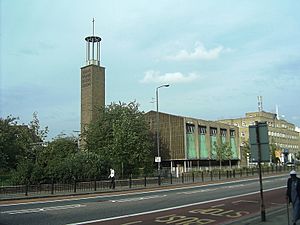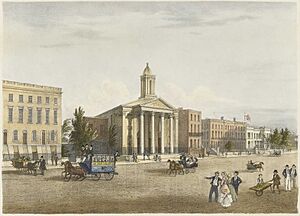Trinity Independent Chapel facts for kids
Quick facts for kids Trinity Independent Chapel |
|
|---|---|

The New Trinity Congregational Church 1951–present
|
|
| Location | London Borough of Tower Hamlets |
| Country | United Kingdom |
| Denomination | Charismatic Baptist, earlier Methodist and Congregationalist |
| Architecture | |
| Architect(s) | William Hosking and John Jay |
The Trinity Independent Chapel is a special church in Poplar, London. It was first built a long time ago, during the early Victorian era. This church was sadly destroyed during the Second World War by a V-2 rocket.
After the war, it was rebuilt in a new, modern style. In the late 1990s, the building became home to the Calvary Charismatic Baptist Church. Today, it serves as their main prayer center and international office.
Contents
History of the Chapel
Building the First Church
The first Trinity Independent Chapel was designed in 1840–41. Two people, William Hosking and John Jay, helped create it. The church was built in Poplar, close to the East India Docks.
It had a grand and beautiful front, mixing old Greek and Italian Renaissance styles. This made the church stand out in the area. At that time, most other chapels in East London looked much simpler.
Who Paid for It?
A rich shipyard owner named George Green paid for the church's design. He was a kind man who supported many good causes in Poplar. He helped build a home for sailors, schools, and homes for the elderly.
Green also started the Trinity Chapel Day School in 1843. Later, this school became part of the London School Board. It is now known as Mayflower Primary School.
The Bell Controversy
George Green and William Hosking wanted to put a bell in their church. This caused a problem with the local Anglican church leaders. They said no other independent church had a bell. So, they made Green and Hosking make the bell silent. They did not want it to compete with their own church bell.
Over time, independent chapels started to look more like Anglican churches. Eventually, the bell was allowed to ring freely.
Life at the Chapel (1860-1944)
The first minister at Trinity Chapel was Rev. George Smith. Even though the chapel was in a busy port area, many people living nearby were very poor.
Under the leadership of Rev. William Dick, the chapel became a place of hope. It worked hard to improve the lives of local people. This was a big part of its Christian mission.
War and Rebuilding
The first chapel survived the early bombings of the Blitz during World War II. But in 1944, a powerful V-2 rocket hit and destroyed it. The only part that survived was the bell. It had rung for the last time on the day war was declared in 1939.
The bell was later fixed and used in the new church.
A Modern New Church
The new church, called the New Trinity Congregational Church, was built on the same spot. It was part of a special event called the Festival of Britain in 1951. The new church was built in a bold, very modern style. It used new materials like concrete and new building methods.
The church continued its important social work. It helped people in the community, just as the old church had done. The area around the church was part of the Lansbury Estate development. This estate was named after George Lansbury, a politician who cared deeply about helping people in need.


